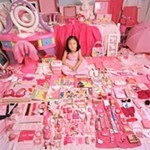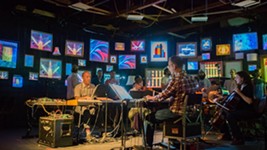Prints Charming
Marking Austin's Museum of Art's "Fresh Ink" Exhibit
By Rebecca S. Cohen, Fri., Feb. 21, 1997

Untitled (dark shapes/two lillies), 1993. Monotype, 42x28 inches. Published by Flatbed Press. |
"Fresh Ink" is an exhibition that fulfills a number of goals that a community museum ought to embrace. First and foremost, it highlights regional artists while placing them in a national context. Austinite Amy MacHugh Moen's mysterious little intaglios (especially Examination, a stone-and-plate lithograph with intaglio) hold their own just fine in an exhibition that includes Robert Wilson's prints. The 96-inch high monotype with chine collé by New York artist Dan Rizzie towers above the prints around it with its mysterious colors and playful curlicue shapes, but the monotypes by local artist Sydney Yeager have equally beautiful painterly surfaces and subtle colors.
In addition, this show highlights local commercial and non-profit facilities that provide an important resource for the local art community and for artists who come from far away to take advantage of their expertise and facilities. The prints here by some 85 different artists exhibit a wide range of personal styles and printmaking techniques, and prove the quality and skill of these Austin print shops and UT's Guest Arts in Printmaking Program. The exhibition also reinforces the commitment of the individuals, non-profit groups, and commercial galleries involved in publishing the prints. It validates the judgment of curators and collectors who have added these prints and others to private and museum collections across the country. For the record, I certainly felt validated to find a handful of prints that I've purchased over time in this museum exhibition.
My own love affair with the print medium began more than 30 years ago when I was in art school. As I gouged wood blocks, dipped copper plates into acid, and drew on huge lithographic stones, I loved the risk-taking, the reversed imagery, the surprise of peeling a damp piece of paper off the press to see, finally, the results of my labors. And then I began all over again, re-etching the plate, scraping the stone. I suppose there is an element of masochism inherent in the convoluted process of making prints versus a more direct medium like drawing.
But when artists whose primary method of production is not printmaking work with master printmakers in a local shop like Flatbed Press, Strike Editions, Slugfest Printmaking Workshop and Studios, or Coronado Studios, they can bypass the pain while retaining the joy of experimentation and discovery. Technicians such as Flatbed's Katherine Brimberry (whose mysterious print Heart's Garden is in the exhibition) work with artists preparing plates, pulling proofs, editioning the final print, and suggesting ways to enhance the print to reflect the intent of the artist. The process becomes truly a collaborative one as the artist's ideas emerge clothed in a new medium. "The artist makes all of the artistic decisions regarding the image," says exhibition curator Dr. Mark L. Smith, "but is guided by the master printer regarding the technical aspects of how to create it."
By making prints, Austin painters such as Fidencio Duran (best known for his public art project murals), Michael Ray Charles (whose paintings, big as old-time circus posters on canvas, have a national following), and Peter Saul (known for his large, brilliantly colored canvases) are able to produce work that is smaller, more accessible in price, and yet still representative of their personal vision. (Here, Saul's black-and-white lithograph even allows one to focus on his bizarre imagery without being distracted by his colors.) Similarly, sculptors such as Luis Jimenez, James Surls, and Michael Tracy can produce two-dimensional works which speak to the same subjects as their sculpture or installations. As is evident in "Fresh Ink," Jimenez's wry commentary -- his Othello featuring O.J. Simpson is a must-see -- Surls' wood-sprite mysticism, and Tracy's in-your-face rituals are certainly present, even enhanced, and definitely made more accessible by the print medium. Printmaking has always been used to increase the accessibility of art and ideas to an extended audience. The production of multiple originals allows for multiple sales to a larger audience at more affordable prices.

El Tiradito, by Luis Jiminez, 1996. Edition of 10 setone lithographs, 38x50 inches. Published by Coronado Studios. |
Although former museum director Daniel Stetson and former museum curator Peter Mears conceived the idea for "Fresh Ink," Smith, a co-founder of Flatbed Press and the recently-appointed assistant to UT Dean of the College of Fine Arts, was a natural choice to curate the exhibition after Stetson's departure from AMOA. Smith was there at the beginning. He was an active partner at Flatbed when Jack Hanley "tortured" a large intaglio plate to achieve the richly textured blood-red backdrop for Plague Doctor. Smith was instrumental in producing Robert Levers' Victory: The Celebration, a commentary on war. And Smith officed at Flatbed when Strike Editions operated next door, along with Ken Hale's KJH Press. He is able to -- and does -- provide a solid overview of the development of the contemporary print workshop and, specifically, how Austin's shops have enthusiastically joined in the production of prints. The sheer quantity of work in the show -- more than a hundred prints -- is only a fraction of what has been produced through these venues and firmly establishes the impact of Austin's print shops. Still, a second catalog essay from an authority outside of Austin would have lent additional credibility to Smith's assertion that "`Fresh Ink' demonstrates that the works generated in Austin's print workshops have reached a critical mass of artistic importance."
Arranging an exhibition as large as this one is a daunting task. The entire exhibition space is filled with prints, with no single visual image or theme uniting them. Serigraphy's hard-edge images work in opposition to lithography's characteristic crayon drawings on stone and the subtle effects of an intaglio over chine collé. Do you arrange the work by medium? Hardly. "Once, the specialties were segregated," says Smith, "[but] now, whatever serves the image best is used, in limitless combinations." He gives as an example Michael Ray Charles's print Black Cats Go Off!, which includes aluminum-plate photo-lithography, etching and aquatint, lino-cut, blind embossing, stenciling, and hand-coloring. Julie Broberg's deceptively simple Interior with White Basin includes hand-coloring. Bogdan Perzynski's Pleasure combines collage and photo-lithography. (I used to have the pleasure of owning Pleasure, and I miss it still.) Should the work be grouped in rooms according to individual print shops? According to color or size? Maybe just alphabetized by artist, beginning with "A"? No.
Arranging pictures in an exhibition requires, above all, a good eye. Friendly dialogues between one print and the next need to be encouraged; "arguments" between them should be discouraged. Each work has to be seen on its own terms, to the extent possible, without interference from other prints. A grouping of prints from Coronado Studios -- including artists Leticia Huerta, Laura Garanzuay, Pio Pulido, Candace Briceño, and Deann Acton -- is easy to "read." Their intense colors and themes echo the Latina exhibition which preceded them in the same gallery space. But the museum missed entirely on the placement of Roger Herman's astonishing multi-panel, two-color woodblock. The 114" x 601/2" image serves more as decoration than as a coherent image because you can't stand back far enough to get a complete view. Gary Washmon's dark color linocut with monotype looms high like a vulture over four smaller works, making it difficult really to see any one of them. The back corner gallery with its green walls seems a bit too subdued. Strike Editions and Galeria Sin Fronteras appear to have been segregated from the rest of the show. Clearly, the exhibition is flawed; missed opportunities abound, but there are few mortal sins. Frankly, there is so much fine work, I might have been satisfied to have seen it leaning against the wall.
The curator's statement posted on the wall suggests that while the purpose of "Fresh Ink" is to explore the production of collaborative printmaking workshops in Austin, the underlying reason he selected each work in the show was the individual power of its image. In his catalog essay, Smith writes:
They are about content, not technique. We may relish the sensual nuances of a print's physical properties or be dazzled by a technical tour de force, but in the end, it's not technical ambition or virtuosity that we seek in a print, but rather, the force of its meaning.
The catalog for the exhibition arrived in my mailbox a couple of days before the opening reception, thanks to AMOA's attentive public relations staff. The production of a 48-page catalog -- whether with black-and-white or color images -- is a major feat (and a not insubstantial expense) for any community museum. Producing it in time for the opening is equally impressive. On the other hand, I hate catalogs that make big work look small and precious (again, Roger Herman suffers) and reproduce smaller prints in a scale that is totally out of line with their actual size. This catalog scrambles the size and importance of work in the show and falls substantially short of reproducing the bulk of prints in the exhibition. Still, I noticed books flying off the gift shop shelves at the opening, affirming the enthusiasm experienced by those who had come to see the exhibition and wanted a remembrance to take with them. I am certainly pleased to have my own copy, and not simply because I am mentioned for having published several prints for gallery artists a long time ago.
I've visited the exhibition three times and still find fresh images in "Fresh Ink." So don't wait for those out-of-town visitors before going to the museum. Check out this show for yourself.
"Fresh Ink" continues through April 13 at the Austin Museum of Art, Downtown, 823 Congress.
Rebecca S. Cohen is an arts writer and recovering art dealer.








